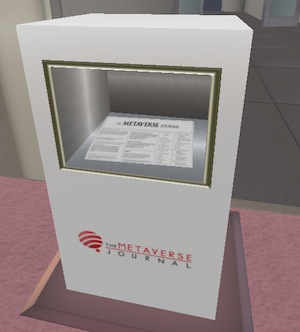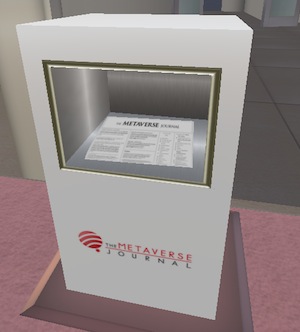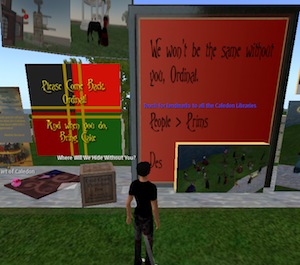 1. ReadWriteWeb (USA) – Kids on The Web: Are They Satisfied With Virtual Worlds and Games? “For kids under 12 years of age, entertainment websites and virtual worlds are all the rage. My 8-year old daughter plays ToonTown a lot. Club Penguin and Moshi Monsters are also popular in this demographic. But are these types of sites fulfilling the potential and talent our kids have with technology? In order to help us answer that question, we’re asking those of you who are parents of a child aged 12 or under to do a short survey accompanied by your child. With this survey, co-hosted by Boston research firm Latitude, we’re hoping to discover what kind of web apps kids want but don’t necessarily have right now.”
1. ReadWriteWeb (USA) – Kids on The Web: Are They Satisfied With Virtual Worlds and Games? “For kids under 12 years of age, entertainment websites and virtual worlds are all the rage. My 8-year old daughter plays ToonTown a lot. Club Penguin and Moshi Monsters are also popular in this demographic. But are these types of sites fulfilling the potential and talent our kids have with technology? In order to help us answer that question, we’re asking those of you who are parents of a child aged 12 or under to do a short survey accompanied by your child. With this survey, co-hosted by Boston research firm Latitude, we’re hoping to discover what kind of web apps kids want but don’t necessarily have right now.”
2. VentureBeat (USA) – New Zealand’s MiniMonos raises $550,000 for kids virtual world. “Virtual worlds aren’t exactly fashionable these days. They went through a hype cycle when everyone predicted that we’d all be living virtual lives in online worlds like Second Life. Now our expectations of them are more down to earth — but new virtual worlds continue to pop up. MiniMonos is the latest. The Christchurch, New Zealand-based company has raised $800,000 in New Zealand dollars ($550,000 U.S.) for a virtual world for children.”
3. Inside Higher Ed (USA) – ‘The Warcraft Civilization’. “Virtual worlds have been making headlines in higher ed for a number of years now. From The Sims to Second Life, all-encompassing video games have caught the attention (favorable or otherwise) of faculty and administrators as well as students. But it’s safe to say that few have explored virtual realities with the fervor of sociologist William Sims Bainbridge. Bainbridge — who is currently co-director of Human-Centered Computing at the National Science Foundation and adjunct professor of sociology at George Mason University — spent over 2,300 hours (that’s more than a year of 40-hour work weeks, if you’re counting) playing World of Warcraft as part of the research for his latest book, The Warcraft Civilization: Social Science in a Virtual World (MIT Press). Bainbridge spoke to Inside Higher Ed via e-mail, discussing what he’s learned from and about virtual worlds — and the vast potential they offer for future research.”
4. Wall Street Journal (USA) – Zynga To Buy Social Gaming Developer Serious Business. “In just two-plus years, social gaming is proving to be a lucrative business for Internet start-ups, particularly for the largest maker of these games, Zynga Inc. The San Francisco company, founded in 2007, has put some of the $180 million it raised in December to work, acquiring smaller and younger rival Serious Business Inc., also backed by venture capital. Terms of the deal weren’t disclosed. Zynga, whose popular games include “FarmVille” and “Mafia Wars,” is the oldest in the nascent social-gaming industry and also the largest with more than 235 million monthly users. The company is reportedly generating upwards of $250 million in revenue per year. It also develops games for Apple Inc.’s (AAPL) iPhone. Its two biggest rivals are Playfish Inc., which was acquired by Electronic Arts Inc. (ERTS) for $300 million in November, and Playdom Inc., which a day later raised an unusually large $43 million first-round of venture funding. Playfish was founded in 2007 like Zynga and has more than 49 million monthly active users, while Playdom, which has said it’s profitable, was formed in 2008 and boasts 25 million monthly active users, according to Appdata.”
5. Psychology Today (USA) – Cool Intervention #2: Virtual Reality. “Get ready for Avatar-meets-Xbox-meets-Freud’s-couch as techies like USC’s Skip Rizzo usher psychotherapy out of the 1980s and into the information age. Just in time to become one of the Ten Coolest Therapy Interventions. When it comes to technology, psychotherapy has woefully trailed the other sciences. Biology, physics, chemistry, engineering and other “hard sciences” pounced on each technological advance to squeeze every last kilobyte of data from the research. For years their supercomputers thundered away while psychology gingerly tapped at a Commodore 64. Geophysicists studied paleomagnetism using an arsenal of techno-gagetry and we hand-scored Rorschachs with our trusty slide rule and abacus. In a field that takes pride in its progressive thinking, psychology was largely comprised of Luddites. Until now.”
6. Mashable (USA) – Glitch: Flickr’s Stewart Butterfield Explains His Ambitious Online Game. “Flickr co-founder Stewart Butterfield and five other former Flickr employees are joined by one Digg alum, one games expert and several freelancers in Tiny Speck, a company that’s working on an online game that has a shot at rebooting the stagnating massively multiplayer online game genre. The 2D game — called Glitch — incorporates beautiful illustrations and cutting edge game mechanics, but its most interesting features are its social aspirations and the lessons it learns from the web that its founders mastered at their previous gigs.”
7. Gizmodo (Australia) – Apple Patent Shows A 3D Virtual World For Buying Their Goods In. “There was a time, before Avatar, when 3D meant crummy virtual gaming. A recent patent granted to Apple shows they are (or were) considering a 3D virtual Apple Store – a more welcoming way to shop for Apple products.”
8. The Sunday Leader (Sri Lanka) – Avatar As America’s Political Unconscious. “When one watches James Cameron’s Avatar one is tempted to dismiss it as a special effects film with a very traditional plot. After all, what is new about a story that tells you about a hero, Jake, a paraplegic war veteran, who leads a resistance against bad Americans? The film uses some hyper-romantic version of primitivism to talk of a better world. The simple, nature-connected natives are good; the technologically-advanced, materialistic Americans are bad. The bad Americans want to conquer the resources of the planet Pandora, and when the natives get in the way of this they must be pushed out or exterminated.”
9. TechCrunch (USA) – In English-Crazy China, 8D World Teaches Kids To Speak In Virtual Worlds; Lands A Deal With CCTV. “In China, learning spoken English is giving rise to a huge and growing market. For instance, in addition to English classes in public schools, parents send their children to about 50,000 for-profit training schools around the country, where English is the most popular subject. Instead of American Idol, on CCTV, the national government-owned TV network, they have the Star of Outlook English Talent Competition. This is possibly the largest nationwide competition in China. Last year, 400,000 students between the ages of 6 and 14 took part in it.”
10. Virtual Worlds News (USA) – Weopia Launches Dating Virtual World. “Virtucom announced the launch of its entrance to the virtual worlds space today: Weopia, a virtual world aimed at bridging the gap between meeting someone through an online dating service and then meeting in the real world. Unlike Utherverse, which looked to partner with sites like Flirt.com, Weopia stands alone–something that may be an extra hurdle in the way of users downloading the software. It sounds, though, like Weopia envisions itself as related to other sites: users pick the person they want to chat with in the virtual world and share a link to their private space rather than mingling with strange avatars. Matches occur elsewhere, and meetings occur in Weopia.”





Recent Comments